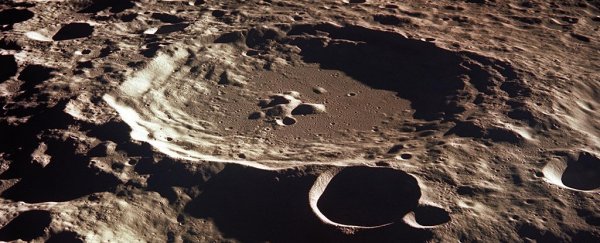What ancient secrets does the pock-marked, crater-covered surface of the Moon hide? A new study suggests giant meteorite smashes played a major role in the process of the Moon's crust formation some 4 billion years ago.
It's one of those areas of science with several competing ideas and hypotheses, all highly debated. One suggestion planetary scientists have had is that magma rising up from the lunar interior is mostly responsible for forming the crust that covers the Moon today.
But researchers came up with the giant meteorite proposal after studying a Moon rock brought back from the Apollo 17 mission in 1972 (the last time humans stepped foot on the Moon). Those rocks show signs of having been exposed to ultra-hot temperatures in excess of 2,300 degrees Celsius (or 4,172 degrees Fahrenheit) way back in the mists of time.
Those sorts of temperatures are usually only achieved through the large-scale melting of a planet's outer layer, which indicates the Moon may have ended up the way we see it now due to undergoing a serious pummelling from massive space objects.
"By first looking at this rock, I was amazed by how differently the minerals look compared to other Apollo 17 samples," says planetary scientist Ana Černok, from the Royal Ontario Museum in Canada.
"Although smaller than a millimetre, the baddeleyite grain that caught our attention was the largest one I have ever seen in Apollo samples. This small grain is still holding the evidence for formation of an impact basin that was hundreds of kilometres in diameter."
The mineral baddeleyite - also known as zirconia or zirconium dioxide - indicates the former presence of cubic zirconia, which is where the super-high temperatures come into play; it means that signs of that incredible heat are still present in rocks we can pick up on the Moon today.
The discovery was made through the use of a complex technique known as electron backscatter diffraction, and further radiometric age dating analysis put the formation of cubic zirconia at more than 4.3 billion years ago – when the Moon was just a baby.
In total, more than 50,000 measurements were made of the tiny grain, showing the interlocking crystal orientations that are the tell-tale signs of ultra-high temperature cubic zirconia.
Both the Moon and Earth have a long history of meteorite impacts, though it's more evident on the Moon – without erosion or plate tectonics, the impact craters stay fixed in place on the lunar surface.
Now it would seem that past impacts are responsible for the very formation of the Moon's crust in the first place.
"The discovery reveals that unimaginably violent impact events helped to build the lunar crust, not only destroy it," says geologist James Darling, from the University of Portsmouth in the UK.
"Going forward, it is exciting that we now have laboratory tools to help us fully understand their effects on the terrestrial planets."
The research has been published in Nature Astronomy.
